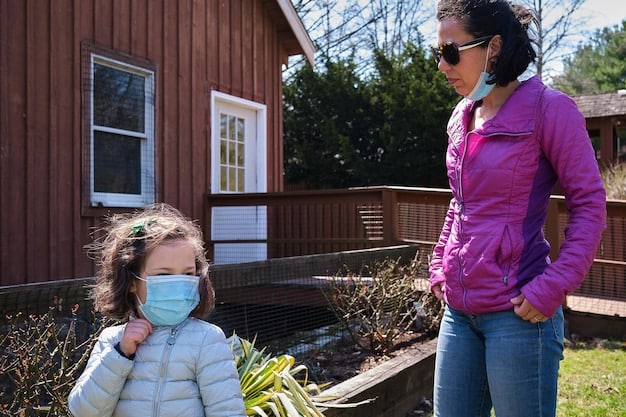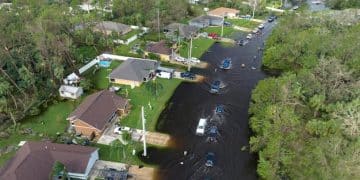Extreme Weather Shelters: Your Options & Rights in a US National Emergency

Navigating extreme weather events in the United States requires understanding your options and rights regarding emergency shelters during a national emergency, encompassing diverse facility types, accessibility, and critical support services.
When natural disasters strike, the immediate need for safety and refuge becomes paramount. Understanding your options and rights concerning Extreme Weather Shelters: What Are Your Options and Rights During a National Emergency? is crucial for preparedness and survival. This guide will provide essential information to help you navigate these challenging situations, ensuring you and your loved ones know where to go and what to expect when faced with an impending or ongoing national emergency.
Understanding the Need for Extreme Weather Shelters
Extreme weather events, from hurricanes and blizzards to wildfires and tornadoes, pose significant threats to life and property across the United States. These unpredictable occurrences can render homes unsafe or uninhabitable, compelling individuals and families to seek immediate refuge. Shelters provide a critical lifeline, offering safety, warmth, food, and medical assistance when conventional living arrangements are compromised.
The decision to evacuate to a shelter is often made under duress, driven by official warnings or immediate danger. It’s not just about escaping the elements; it’s about accessing vital resources and support systems that can sustain life during a crisis. Understanding the function and importance of these shelters is the first step in effective emergency preparedness.
The Impact of Climate Change
Climate change is intensifying the frequency and severity of extreme weather events, making the role of emergency shelters even more critical. Communities are experiencing unprecedented floods, heatwaves, and storms, pushing emergency response systems to their limits. Therefore, knowing about shelters is no longer just a contingency plan but an essential part of modern resilience.
- Increased intensity of hurricanes and tropical storms.
- More frequent and severe heatwaves.
- Rise in wildfire occurrences and spread.
- Greater risk of widespread flooding.
These trends highlight the need for robust shelter systems, capable of accommodating a growing population that may be displaced by climate-related disasters. Government agencies and local communities are continuously working to enhance their sheltering capabilities to meet these evolving challenges.
In conclusion, the necessity of extreme weather shelters stems from the inherent dangers of natural disasters and the escalating impact of climate change. They serve as pillars of safety and support, embodying community resilience in the face of adversity. Being informed about these facilities is a proactive measure that empowers individuals to protect themselves and their families.
Types of Emergency Shelters Available in the US
When a national emergency strikes, various types of shelters become operational, each designed to serve specific needs and situations. Understanding these distinctions can help you determine the most appropriate option for your circumstances. From conventional public shelters to specialized private facilities, the shelter network is diverse and adaptable.
The primary goal remains the same: to provide a safe haven. However, the services and environment each type offers can vary significantly. Familiarizing yourself with these options before a crisis can reduce stress and ensure a smoother transition to safety.

Public Shelters: Government and Community-Managed
Public shelters are typically managed by government agencies like the Federal Emergency Management Agency (FEMA) in collaboration with local authorities and non-profit organizations such as the American Red Cross. These are often set up in schools, community centers, or large public buildings that can accommodate many people.
They are general population shelters, meaning they cater to a wide range of needs. Services usually include temporary lodging (cots, blankets), basic meals, first aid, and emotional support. Accessibility for individuals with disabilities is generally a priority, though specific accommodations should be confirmed in advance.
- American Red Cross shelters: Widely known and operated for various disasters.
- FEMA-designated shelters: Activated during federal emergencies.
- Local government shelters: Often organized by city or county emergency management.
These shelters are designed for short-term stays, typically spanning days to weeks, depending on the severity and duration of the emergency. They emphasize safety, basic needs, and a structured environment to maintain order and provide critical aid.
Specialized and Pet-Friendly Shelters
Beyond general population shelters, there are specialized facilities catering to unique requirements. Pet-friendly shelters have become increasingly common, recognizing the emotional bond between people and their animals and preventing individuals from avoiding evacuation due to pet concerns. While not universally available, many communities now offer co-location or separate pet shelters.
Furthermore, some shelters are equipped to handle specific medical needs, offering a higher level of care for individuals with chronic conditions or those requiring oxygen and other medical equipment. It’s crucial to identify these special needs shelters in advance if you or a family member require such support.
Private and Community-Based Shelters
In addition to official public shelters, many communities have established private or community-based shelters, often run by churches, civic organizations, or private businesses. These may operate independently or in conjunction with local emergency services.
While potentially smaller and with varying service levels, they can offer valuable alternatives, especially in less severe emergencies or for those seeking a more communal atmosphere. It’s advisable to check with local authorities for a comprehensive list of all operational shelters during an emergency.
In summary, the array of emergency shelters available in the US ranges from large-scale government-run facilities to specialized and community-based options. Understanding these types ensures that affected individuals can make informed decisions about their safety and well-being during a national emergency.
Your Rights as an Evacuee in a National Emergency
During a national emergency, evacuees entering shelters retain certain fundamental rights designed to ensure their safety, dignity, and well-being. These rights are often enshrined in emergency management policies and humanitarian principles, aiming to provide a supportive environment amidst crisis.
Understanding these rights empowers individuals to advocate for themselves and their families, ensuring they receive appropriate care and treatment. While the specific implementation may vary by location and the nature of the emergency, core protections generally apply across the board.
Right to Safety and Basic Necessities
Every individual in a designated emergency shelter has the right to a safe environment, free from threats and hazards. This includes protection from violence, exploitation, and discrimination. Shelters are tasked with maintaining order and security to ensure the safety of all occupants.
Beyond safety, evacuees have a right to basic necessities. This typically encompasses access to:
- Clean and safe temporary lodging, such as a cot or designated space.
- Potable water for drinking and hygiene.
- Nutritious meals, mindful of dietary restrictions where possible.
- Basic sanitary facilities, including restrooms and hygiene supplies.
- Essential medical assistance for injuries or acute health conditions.
These provisions are fundamental to sustaining life and health during displacement. While not luxurious, they are designed to meet basic human needs in extraordinary circumstances.
Right to Information and Communication
Evacuees have the right to receive clear and timely information regarding the emergency situation, shelter operations, and available services. This includes updates on the disaster, return-home timelines, and resources for recovery. Effective communication channels should be established within the shelter.
Furthermore, reasonable efforts should be made to facilitate communication between evacuees and their families or external contacts, where possible. While resources might be strained, the importance of maintaining connections is recognized for mental well-being.
Non-Discrimination and Accessibility Rights
A crucial right within shelters is non-discrimination. Shelters must provide services without prejudice based on race, ethnicity, religion, gender, sexual orientation, disability, or any other protected characteristic. All individuals should be treated with respect and dignity.
For individuals with disabilities, the Americans with Disabilities Act (ADA) often applies, ensuring reasonable accommodations are provided. This includes accessible restrooms, entryways, and communication methods. Families with children, older adults, and other vulnerable populations also have specific protections to ensure their unique needs are met.
In essence, during a national emergency, evacuees are not merely recipients of aid but individuals with inherent rights. These rights are vital in upholding humanitarian standards and ensuring that shelter environments provide not just physical safety but also respect and support for all those affected by disaster.
Preparing for Shelter: What to Pack and What to Expect
The decision to seek refuge in an emergency shelter is often made quickly, but a degree of preparation can significantly ease the transition and improve overall comfort. Knowing what to pack and what to anticipate upon arrival can make a stressful situation more manageable.
While space in shelters is limited, carefully selected items can provide a sense of normalcy and basic necessities that might not be immediately available. Being prepared means thinking ahead about your essential needs and the restrictions you might encounter.
The Essential “Go Bag”
Emergency management agencies consistently recommend preparing a “Go Bag” or “Bug-Out Bag” in advance. This bag should be easily accessible and contain essentials for 72 hours of self-sufficiency. For shelter stays, it’s even more critical, as you might have limited access to external resources.
Key items for your “Go Bag” when heading to a shelter include:
- Identification and Documents: Driver’s license, passport, birth certificates, insurance policies, medical records (copies or originals in a waterproof bag).
- Medications: At least a 7-day supply of all prescription and over-the-counter medications, with a list of dosages and relevant medical conditions.
- Cash: Small bills for incidentals, as ATMs might be non-operational.
- First Aid Kit: Basic supplies for minor injuries and personal hygiene items (toothbrush, soap, hand sanitizer).
- Communication: Fully charged cell phone, charger, power bank, and a list of emergency contacts.
- Clothing: One or two changes of comfortable clothing suitable for the expected climate.
- Food and Water: Non-perishable snacks and a water bottle; shelters provide meals but having extra is prudent.
- Comfort Items: Small blanket, pillow, book, or quiet toy for children.
Avoid packing excessive amounts of clothing or non-essential items, as space will be at a premium.
What to Expect Upon Arrival
Shelters are often large, open spaces, and privacy will be limited. You will likely be assigned a cot or a designated area. The environment can be loud and crowded, with many people experiencing varying levels of stress and anxiety.
Upon arrival, expect a registration process, where you’ll provide basic information for tracking and resource allocation. Rules and regulations will be communicated, covering aspects like quiet hours, meal times, and access to services. Be prepared for communal living and adjust your expectations accordingly.
Staff and volunteers will be present to assist with needs and maintain order. While conditions may be basic, the primary focus is on ensuring safety and providing essential relief. Patience and cooperation are key to a positive experience for everyone.
In conclusion, meticulous preparation of a “Go Bag” and realistic expectations about the shelter environment are fundamental for anyone planning to seek refuge during an extreme weather emergency. These proactive steps can significantly enhance your safety and comfort during a challenging time.
Navigating Specific Challenges in Shelters
While shelters offer vital safety during extreme weather events, living in a communal environment under stressful conditions can present unique challenges. Understanding and proactively addressing these can help evacuees cope more effectively and ensure a smoother experience for everyone involved.
These challenges range from managing personal well-being in a crowded setting to addressing specific needs like those of pets or individuals with disabilities. Awareness and preparedness are key to mitigating their impact.
Health and Hygiene Concerns
Communal living in shelters can elevate the risk of illness transmission. Poor hygiene practices, limited access to sanitation, and close quarters can contribute to the spread of respiratory infections, stomach bugs, and other communicable diseases. Maintaining personal hygiene becomes paramount.
- Frequent handwashing with soap and water or hand sanitizer.
- Using personal hygiene items: toothbrush, soap, towel.
- Adhering to social distancing recommendations if applicable and feasible.
- Reporting any symptoms of illness to shelter staff immediately.
Shelter operations typically include efforts to maintain cleanliness and provide access to basic toiletries, but individual responsibility plays a significant role in preventing disease outbreaks.
Privacy and Mental Well-being
The lack of privacy in shelters can be a significant source of stress and discomfort. Living in an open space with numerous strangers, constant noise, and limited personal space can impact mental well-being. It’s crucial to find small ways to create personal boundaries and seek moments of quiet reflection.
Emotional support is often available through mental health professionals or volunteers. Don’t hesitate to seek their assistance if you are struggling with anxiety, fear, or other emotional responses to the disaster. Many shelters prioritize psychological first aid to help occupants cope with trauma and displacement.
Addressing Special Needs and Pet Accommodations
Evacuees with special needs, such as chronic medical conditions, mobility issues, or cognitive impairments, require specific considerations. While the ADA mandates accessibility, it is critical to communicate these needs to shelter staff upon arrival or even pre-register with emergency services if possible.
For pet owners, separating from beloved animals can be a major barrier to evacuation. While pet-friendly shelters are becoming more common, availability is not universal. Researching local pet-sheltering options in advance of an emergency is vital. If your pet cannot be accommodated, explore boarding facilities or consider staying with friends or family outside the affected area.
Navigating these specific challenges requires a combination of personal resilience, proactive communication with shelter staff, and an understanding of available resources. By being prepared for these realities, evacuees can better protect their physical and mental health during their stay in a shelter.
Post-Shelter Transition and Recovery Resources
The transition from an emergency shelter back to a semblance of normal life is a critical phase of disaster recovery. While immediate safety is provided during the emergency, the period following can be complex, involving emotional, financial, and logistical challenges. Understanding available resources is crucial for a successful recovery.
This phase is not merely about leaving the shelter; it’s about rebuilding lives, homes, and communities. Agencies at federal, state, and local levels, along with non-profit organizations, play a vital role in providing support during this crucial time.

Connecting with Aid Agencies
Upon leaving a shelter, or sometimes even while still housed, evacuees should connect with various aid agencies. FEMA (Federal Emergency Management Agency) is the primary federal agency providing assistance after a declared disaster, offering various programs including financial aid for housing, home repairs, and other serious needs.
The American Red Cross continues to provide services beyond the immediate shelter phase, often offering case management, mental health support, and distributing recovery supplies. Local non-profits and community organizations also step in, providing tailored assistance such as:
- Housing assistance: Temporary rental assistance, information on long-term housing solutions.
- Disaster unemployment assistance: For those whose employment was affected by the disaster.
- Legal aid: Assistance with insurance claims, landlord-tenant issues, or replacement of lost documents.
- Mental health support: Counseling and psychological services to address trauma.
It is important to register with FEMA and other relevant agencies as soon as possible, as deadlines for assistance often apply. Keeping detailed records of expenses and damages is also recommended.
Finding Temporary and Permanent Housing Solutions
For many evacuees, returning home may not be immediately possible due to damage or destruction. Finding temporary housing is often the first step in recovery. This could include:
- Staying with friends or family.
- Temporary rental units funded by FEMA.
- Manufactured housing units provided by the government.
- Hotels or motels, potentially with FEMA reimbursement.
The long-term goal is to secure permanent housing. This might involve repairing a damaged home, rebuilding, or finding a new residence. Resources are available to help navigate these complex processes, from contractors to housing market information.
Emotional and Psychological Recovery
The invisible wounds of disaster can last long after the physical threat has passed. The emotional and psychological toll of displacement, loss, and uncertainty is significant. Access to mental health services is a critical component of post-shelter recovery.
Many organizations offer free or low-cost counseling, support groups, and psychological first aid. Recognizing the signs of trauma and seeking help is crucial for both adults and children. Rebuilding a sense of normalcy and routine is also vital for emotional healing.
In conclusion, the post-shelter transition is a marathon, not a sprint. By leveraging available resources from government agencies and non-profit organizations, and by prioritizing both practical and emotional recovery, evacuees can navigate the challenging path toward rebuilding their lives after an extreme weather emergency.
Legal Frameworks and Government Responsibilities
The operational framework for extreme weather shelters and the rights of evacuees during a national emergency are deeply rooted in a complex weave of legal frameworks and defined government responsibilities. These laws and policies, enacted at federal, state, and local levels, ensure a coordinated and effective response to disasters, while also safeguarding the welfare of affected populations.
Understanding these foundational aspects provides insight into how shelters are established, managed, and how individual rights are upheld, creating a transparent and accountable disaster response mechanism.
The Stafford Act and FEMA’s Role
At the federal level, the primary legislation governing disaster response and assistance is the Robert T. Stafford Disaster Relief and Emergency Assistance Act, commonly known as the Stafford Act. This act provides the legal authority for the President to declare a major disaster or emergency, triggering federal assistance to states and local governments.
Under the Stafford Act, the Federal Emergency Management Agency (FEMA) is charged with coordinating the federal government’s role in preparing for, responding to, and recovering from disasters. FEMA’s responsibilities include providing financial assistance, essential resources, and technical support, which directly impacts the establishment and resourcing of shelters.
- FEMA coordinates federal disaster relief efforts.
- Provides funding for state and local shelter operations.
- Offers guidelines and standards for emergency shelters.
- Supports emergency management planning.
The Stafford Act emphasizes a “whole community” approach, encouraging collaboration between government agencies, non-profits, faith-based organizations, and the private sector in disaster preparedness and response.
State and Local Government Responsibilities
While federal assistance is crucial, state and local governments bear the primary responsibility for disaster preparedness and immediate response, including the designation and operation of emergency shelters. Each state has an emergency management agency, and local jurisdictions (cities, counties) have their own emergency plans and departments.
These entities are responsible for:
- Developing and implementing emergency preparedness plans.
- Identifying and allocating public buildings as potential shelters.
- Training staff and volunteers for shelter management.
- Coordinating with local law enforcement, medical services, and relief organizations.
- Issuing evacuation orders and public warnings.
Their role is critical in the initial hours and days of a disaster, when federal resources might still be mobilizing. Local emergency declarations often precede federal ones, allowing for quicker activation of local assets and existing plans.
Humanitarian Principles and Legal Due Process
Beyond specific disaster legislation, the operation of shelters often adheres to broader humanitarian principles and constitutional rights. These include ensuring non-discrimination, protecting privacy, and providing due process—even in an emergency context. While emergency powers may be invoked, they are typically balanced against individual liberties.
Advocacy groups and legal aid societies monitor shelter conditions and compliance with accessibility laws (like the ADA), ensuring that vulnerable populations receive equitable treatment and necessary accommodations. This legal oversight contributes to the accountability of emergency response efforts.
In conclusion, the efficacy and fairness of extreme weather shelters during a national emergency are undergirded by robust legal frameworks and clearly defined government responsibilities. These ensure that aid is delivered efficiently, and the rights of every evacuee are respected from the moment they seek refuge until they begin their journey of recovery.
| Key Point | Brief Description |
|---|---|
| 🏠 Types of Shelters | Includes public (Red Cross, FEMA), specialized (pet-friendly), and community-based options. |
| ⚖️ Evacuee Rights | Rights to safety, basic necessities, information, non-discrimination, and accessibility. |
| 🎒 Shelter Preparedness | Pack a “Go Bag” with essentials, expect communal living, and plan for limited privacy. |
| ✅ Government Role | Stafford Act empowers FEMA, while states and localities manage primary response and shelter operations. |
Frequently Asked Questions
▼
During an emergency, local news outlets, radio announcements, and official government websites (like your county’s emergency management agency or state EMA) are prime sources. Additionally, the American Red Cross website and their Emergency App often provide real-time shelter locations. FEMA websites might also list activated shelters. Always prioritize official sources for accurate and timely information.
▼
It depends on the shelter. While an increasing number of emergency shelters are becoming pet-friendly or operating co-located pet shelters, it’s not universal. Always check in advance or inquire with local emergency services. If pet accommodations aren’t available, explore alternative arrangements like boarding facilities or staying with friends/family who can accommodate your pet.
▼
Most general population shelters offer basic first aid and can assist with acute medical needs. For complex medical conditions or specific requirements (e.g., oxygen, dialysis), you might need a specialized medical needs shelter. It’s crucial to inform emergency services about your specific medical needs during evacuation planning or upon arrival at a general shelter.
▼
Pack copies or originals of essential documents in a waterproof bag. This includes identification (driver’s license, passport), birth certificates, Social Security cards, insurance policies (home, health, auto), medical records, and bank account information. Having these readily accessible can significantly aid in recovery and accessing post-disaster assistance.
▼
Emergency shelters are designed for temporary relief, typically for days or weeks, depending on the severity and duration of the emergency. They are not long-term housing solutions. As the immediate crisis subsides, shelter operations transition to helping evacuees find more stable temporary housing or aid in their return home, guided by recovery plans.
Conclusion
Understanding your options and rights concerning extreme weather shelters during a national emergency is a cornerstone of effective personal preparedness. From knowing the types of shelters available and what to pack in your “Go Bag,” to recognizing your fundamental rights as an evacuee, being informed empowers you to navigate these challenging situations with greater confidence. While the government plays a crucial role in providing resources and legal frameworks, individual awareness and proactive planning remain paramount. The journey from crisis to recovery is complex, but with knowledge of the sheltering system and available resources, individuals and communities can emerge stronger and more resilient in the face of nature’s unpredictable forces.





